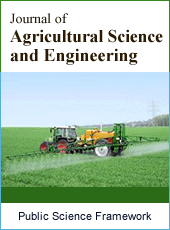Journal of Agricultural Science and Engineering
Articles Information
Journal of Agricultural Science and Engineering, Vol.5, No.2, Jun. 2019, Pub. Date: May 30, 2019
A Portable Orifice Meter for Pump Flow Measurement
Pages: 49-55 Views: 2306 Downloads: 925
[01]
Mahbub Hasan, Department of Civil, Mechanical Engineering & Construction Management, Alabama A&M University, Normal, USA.
[02]
John Replogle, Research Hydraulic Engineering (Retired), Arid Land Agricultural Research Center (ALARC), Phoenix, USA.
[03]
Aschalew Kassu, Department of Civil, Mechanical Engineering & Construction Management, Alabama A&M University, Normal, USA.
[04]
Ashraf Al-Hamdan, Department of Civil and Environmental Engineering, University of Alabama in Huntsville, Huntsville, USA.
Tube well irrigation system serves a significant land area for crop production in Bangladesh. Tube well discharge measurement is very important to schedule irrigation practices, means to decide (a) when to irrigate, and (b) how much of water should be applied into the field. Discharge is measured at the time of tube well commissioning only. Thereafter, no one knows how much of flow size is there in their crop field. This may be due to unknowingness the importance of correct flow size that plays a vital role in crop production. Another severe factor is the unavailability of a suitable equipment for flow size determination which can be manufactured with (a) the locally available materials, (b) the materials cost is cheaper, (c) easy to install and operate, and (d) handy. With this end in view, a portable orifice meter was designed and fabricated in the Agricultural Engineering workshop of Bangladesh Agricultural Institute (BARI). This meter was designed for measuring pump flow size operated for shallow tube wells having 4-inch delivery pipe. Concept of end-cap orifice meter was considered to design this portable orifice meter. Shortening the conventional orifice meter and introducing the slit type (rectangular shaped) at the orifice outlet was found to be a very good, handy, cheaper, simple, and fabricated with locally available materials, and shows a promising agreement while compared the calibrated discharge (Qc) with predicted discharge (Qp). Errors from using the regression equation to obtain discharge ranged from 0.09 to 2.17% whereas the errors ranged from 0.24 to 6.57% when considered the laboratory measure discharges.
Pump Flow Measurement, Orifice Meter, End-Cap Orifice, Vena Contracta Coefficient
[01]
Badar, A. M. and Ghare, A. D. (2012). Development of discharge prediction model for trapezoidal canals using simple portable flume. International Journal of Hydraulic Engineering, 1 (5): 37-42.
[02]
Bos, M. G. (1989). Discharge measurement structures. International Institute for Land Reclamation and Improvement (ILRI), The Netherlands, 3rd Edition, Publication 20.
[03]
Hasan, M., Kassu, A., and Raomentreddy, S. (2018). Determination of evapotranspiration for cotton in Alabama by Penman method. International Journal of Hydrology Science and Technology, Vol. 8, No. 2.
[04]
Hasan, M., and Kassu, A. (2019). Runoff volume by SCS method for Alabama A&M University Agricultural Research Station. International Journal of Hydrology Science and Technology (Accepted).
[05]
Kolavani, F. L., Bijankhan, M., Stefano, C. D., Ferro, V. and Mazdeh, A. M. (2018). Flow measurement using circular portable flume. Flow Measurement and Instrumentation, 62: 76-83.
[06]
Ramirez, B. C., Maia, G. D. N., Green, A. R., Shike, D. W., Gates, R. S. and Rodríguez, L. F. (2013). Design and validation of a calibrated orifice meter for sub-500 liter per minute flow rate applications. American Society of Agricultural and Biological Engineers (ASABE) Annual International Meeting, Paper Number 131618475, Kansas City, Missouri, July 21- 24, 2013.
[07]
Repogle, J. A. and Clemmens, A. J. (1987). Automatic regulation of canal offtakes. Irrigation and Drainage Systems I: 123-142.
[08]
Shan, F., Liu, Z., Liu, W. and Tsuji, Y. (2016). Effects of the orifice to pipe diameter ratio on orifice flows. Chemical Engineering Science, 152: 497-506.
[09]
Muñoz-Díaz, E., Solorio-Ordaz, F. and Ascanio, G. (2012). A numerical study of an orifice flowmeter. Flow Measurement and Instrumentation, 26: 85-92.
[10]
Shah, M. S., Joshi, J. B., Kalsi, A. S., Prasad, C. S. R. and Shukla, D. S. (2012). Analysis of flow through an orifice meter: CFD simulation. Chemical Engineering Science, 71: 300-309.
[11]
Samani, Z. (2017). Three simple flumes for flow measurement in open channels. Journal of Irrigation and Drainage Engineering, 143 (6): 04017010.
[12]
Bidkar, K. L., Phalak, K. T., Jadhao, P. D. (2015). Comparative study of flow measuring devices for low discharge. IJCSN International Journal of Computer Science and Network, 4 (2): 341-345.
[13]
Rhinehart, R. R., Gebreyohannes, S., Sridhar, U. M., Patrachari, A. and Rahaman, M. S. (2011). A power law approach to orifice flow rate calibration. ISA Transactions, 50 (2): 329-341.
[14]
Layne and Bowler, Inc. (1958). Measurement of water flow through pipe orifice with free discharge. A Marley Company Publication with Orifice Calibration, Purdue University, Lafayette, Indian. 28 p.
[15]
ASME. (1959). Fluid Meters: Their Theory and Applications. A Committee on Fluid Meters, 5th Edition, pp. 203, New York.

ISSN Print: 2381-6821
ISSN Online: 2381-6848
Current Issue:
Vol. 7, Issue 4, December Submit a Manuscript Join Editorial Board Join Reviewer Team
ISSN Online: 2381-6848
Current Issue:
Vol. 7, Issue 4, December Submit a Manuscript Join Editorial Board Join Reviewer Team
| About This Journal |
| All Issues |
| Open Access |
| Indexing |
| Payment Information |
| Author Guidelines |
| Review Process |
| Publication Ethics |
| Editorial Board |
| Peer Reviewers |


